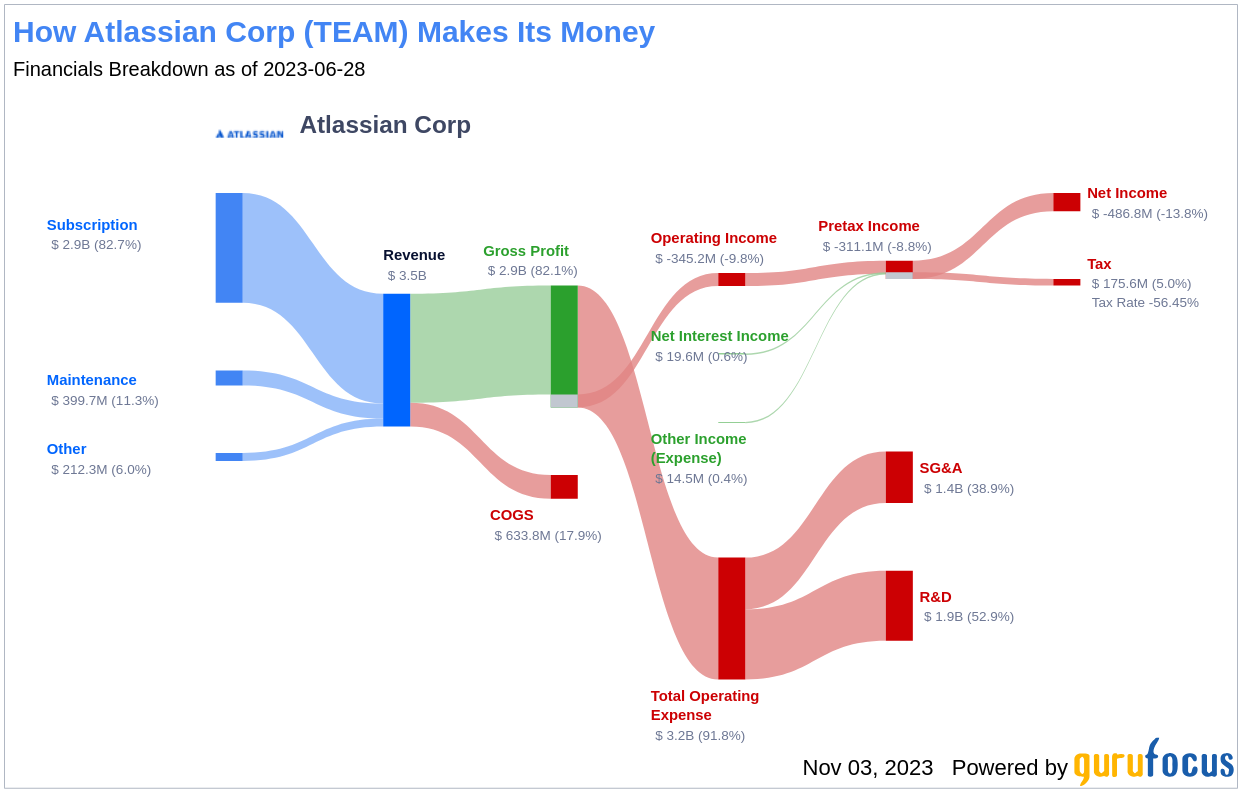Atlassian Corp (TEAM, Financial) experienced a daily loss of 6.78%, with a 3-month gain of 1.28% and a reported Loss Per Share of 1.89. The question that arises is: Is the stock significantly undervalued? This article aims to answer this question by providing a detailed valuation analysis. We invite you to delve into the following analysis to understand Atlassian's true market value.
A Snapshot of Atlassian Corp (TEAM, Financial)
Founded in 2002 and headquartered in Sydney, Atlassian Corp produces software that enhances team efficiency and effectiveness. The company provides project planning and management software, collaboration tools, and IT help desk solutions. It operates in four segments: subscriptions, maintenance, perpetual license, and other services, including training, strategic consulting, and revenue from the Atlassian Marketplace app store.
Atlassian's stock price stands at $169.1, with a market cap of $43.70 billion. But how does this compare with the company's intrinsic value, as estimated by the GF Value? Let's delve deeper into the company's valuation.
Understanding the GF Value of Atlassian (TEAM, Financial)
The GF Value is a proprietary measure that represents the current intrinsic value of a stock. It is calculated based on historical multiples, a GuruFocus adjustment factor based on the company's past performance and growth, and future business performance estimates. The GF Value Line on our summary page provides an overview of the fair value at which the stock should ideally be traded.
According to GuruFocus' valuation method, Atlassian's stock is significantly undervalued. The GF Value estimates the stock's fair value based on three key factors: historical multiples, an internal adjustment based on the company's past business growth, and analyst estimates of future business performance. If the stock's share price is significantly above the GF Value Line, the stock may be overvalued and have poor future returns. On the other hand, if the stock's share price is significantly below the GF Value Line, the stock may be undervalued and have high future returns.
At its current price of $169.1 per share, Atlassian has a market cap of $43.70 billion and the stock is believed to be significantly undervalued. Because Atlassian is significantly undervalued, the long-term return of its stock is likely to be much higher than its business growth.
Link: These companies may deliver higher future returns at reduced risk.
Assessing Atlassian's Financial Strength
Investing in companies with low financial strength could result in permanent capital loss. Therefore, it's crucial to carefully review a company's financial strength before deciding whether to buy shares. Looking at the cash-to-debt ratio and interest coverage can give a good initial perspective on the company's financial strength. Atlassian has a cash-to-debt ratio of 1.65, which ranks worse than 57.53% of 2741 companies in the Software industry. Based on this, GuruFocus ranks Atlassian's financial strength as 6 out of 10, suggesting a fair balance sheet.
Evaluating Atlassian's Profitability and Growth
Investing in profitable companies carries less risk, especially in companies that have demonstrated consistent profitability over the long term. Typically, a company with high profit margins offers better performance potential than a company with low profit margins. Atlassian has been profitable 3 years over the past 10 years. During the past 12 months, the company had revenues of $3.50 billion and a Loss Per Share of $1.89. Its operating margin of -9.77% is worse than 67.77% of 2768 companies in the Software industry. Overall, GuruFocus ranks Atlassian's profitability as fair.
Growth is probably one of the most important factors in the valuation of a company. GuruFocus' research has found that growth is closely correlated with the long-term performance of a company's stock. If a company's business is growing, the company usually creates value for its shareholders, especially if the growth is profitable. Likewise, if a company's revenue and earnings are declining, the value of the company will decrease. Atlassian's 3-year average revenue growth rate is better than 82.8% of 2396 companies in the Software industry. Atlassian's 3-year average EBITDA growth rate is -1.8%, which ranks worse than 66.93% of 1993 companies in the Software industry.
Atlassian's ROIC vs WACC
Another method of determining the profitability of a company is to compare its return on invested capital to the weighted average cost of capital. Return on invested capital (ROIC) measures how well a company generates cash flow relative to the capital it has invested in its business. The weighted average cost of capital (WACC) is the rate that a company is expected to pay on average to all its security holders to finance its assets. When the ROIC is higher than the WACC, it implies the company is creating value for shareholders. For the past 12 months, Atlassian's return on invested capital is -18.83, and its cost of capital is 8.89.
Conclusion
In conclusion, Atlassian (TEAM, Financial) is significantly undervalued. The company's financial condition is fair, and its profitability is fair. Its growth ranks worse than 66.93% of 1993 companies in the Software industry. To learn more about Atlassian stock, you can check out its 30-Year Financials here.
To find out the high-quality companies that may deliver above-average returns, please check out GuruFocus High Quality Low Capex Screener.
This article, generated by GuruFocus, is designed to provide general insights and is not tailored financial advice. Our commentary is rooted in historical data and analyst projections, utilizing an impartial methodology, and is not intended to serve as specific investment guidance. It does not formulate a recommendation to purchase or divest any stock and does not consider individual investment objectives or financial circumstances. Our objective is to deliver long-term, fundamental data-driven analysis. Be aware that our analysis might not incorporate the most recent, price-sensitive company announcements or qualitative information. GuruFocus holds no position in the stocks mentioned herein.




